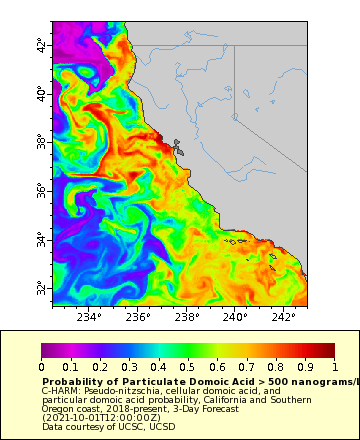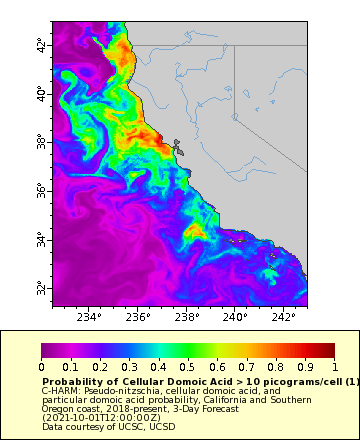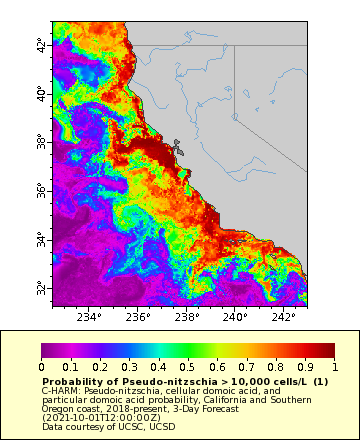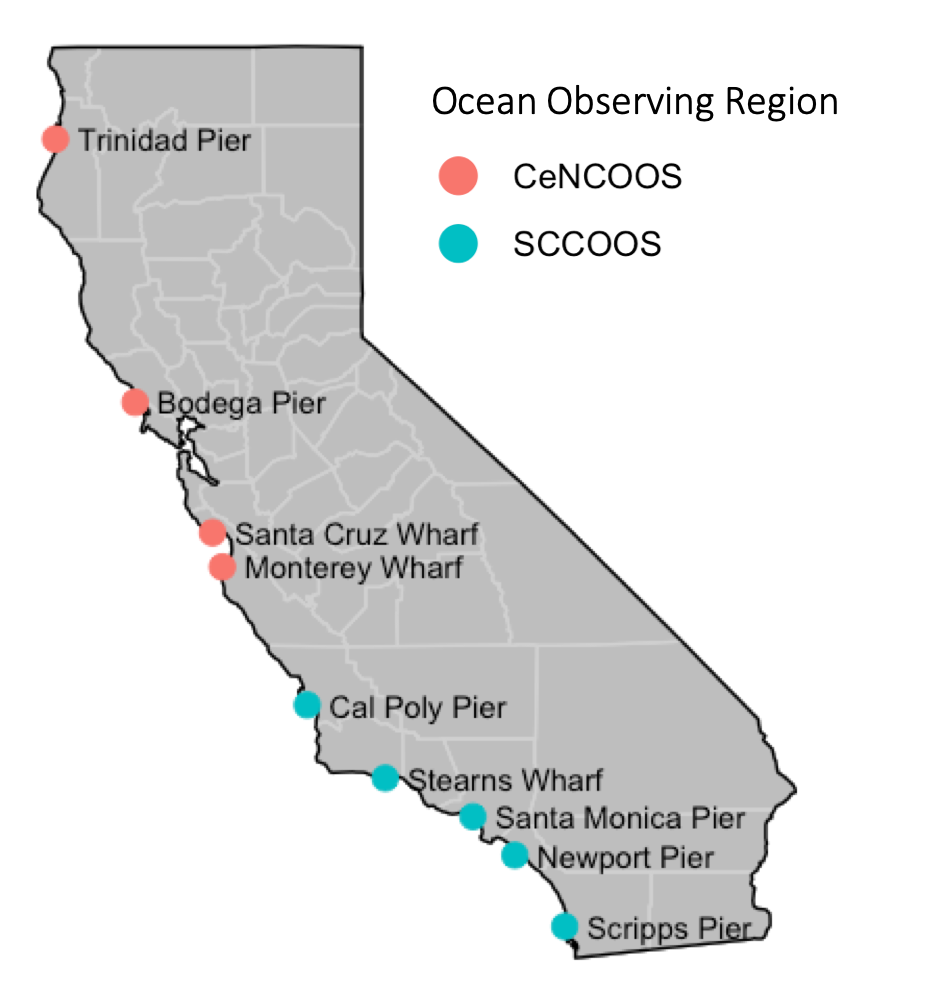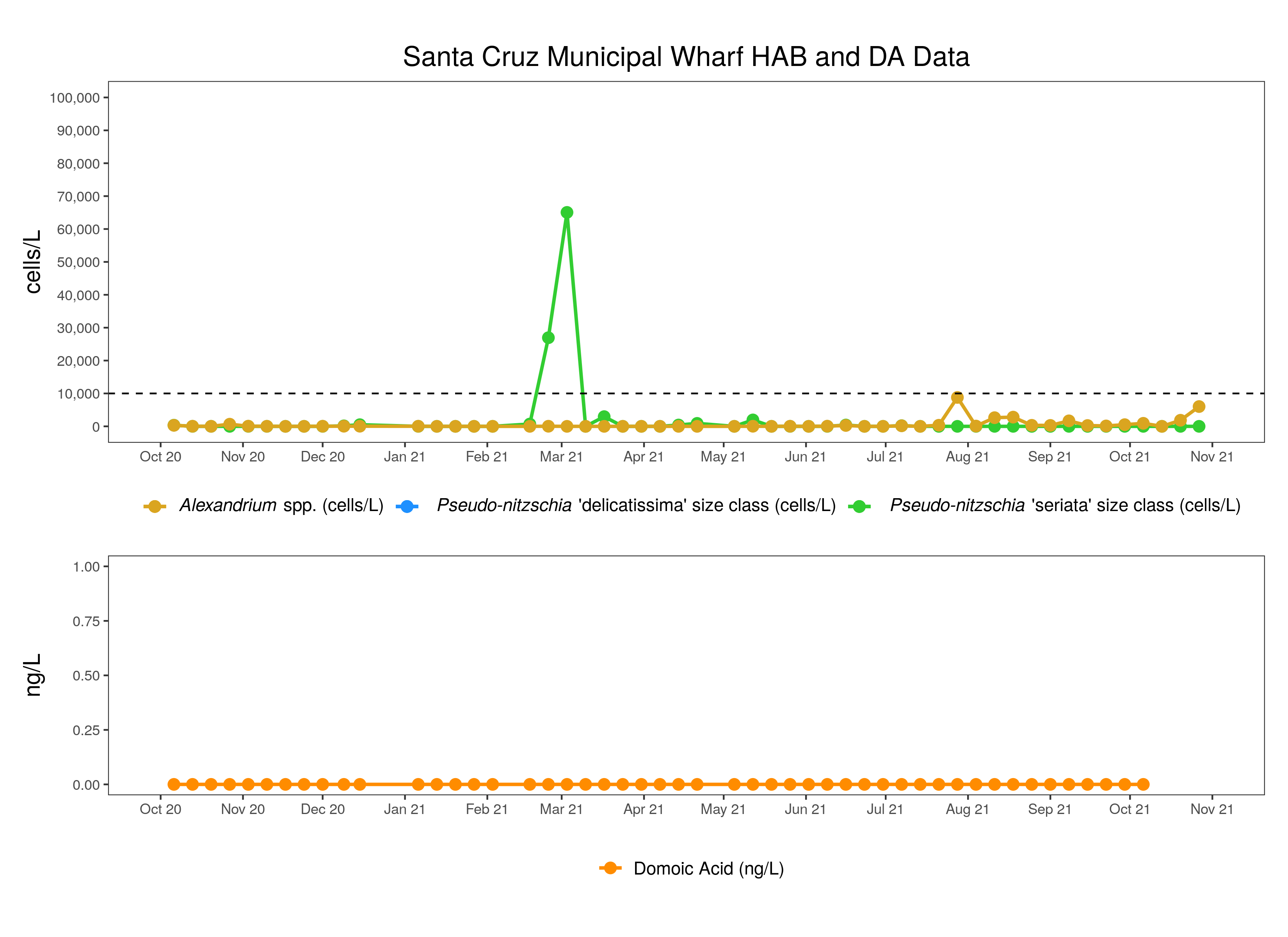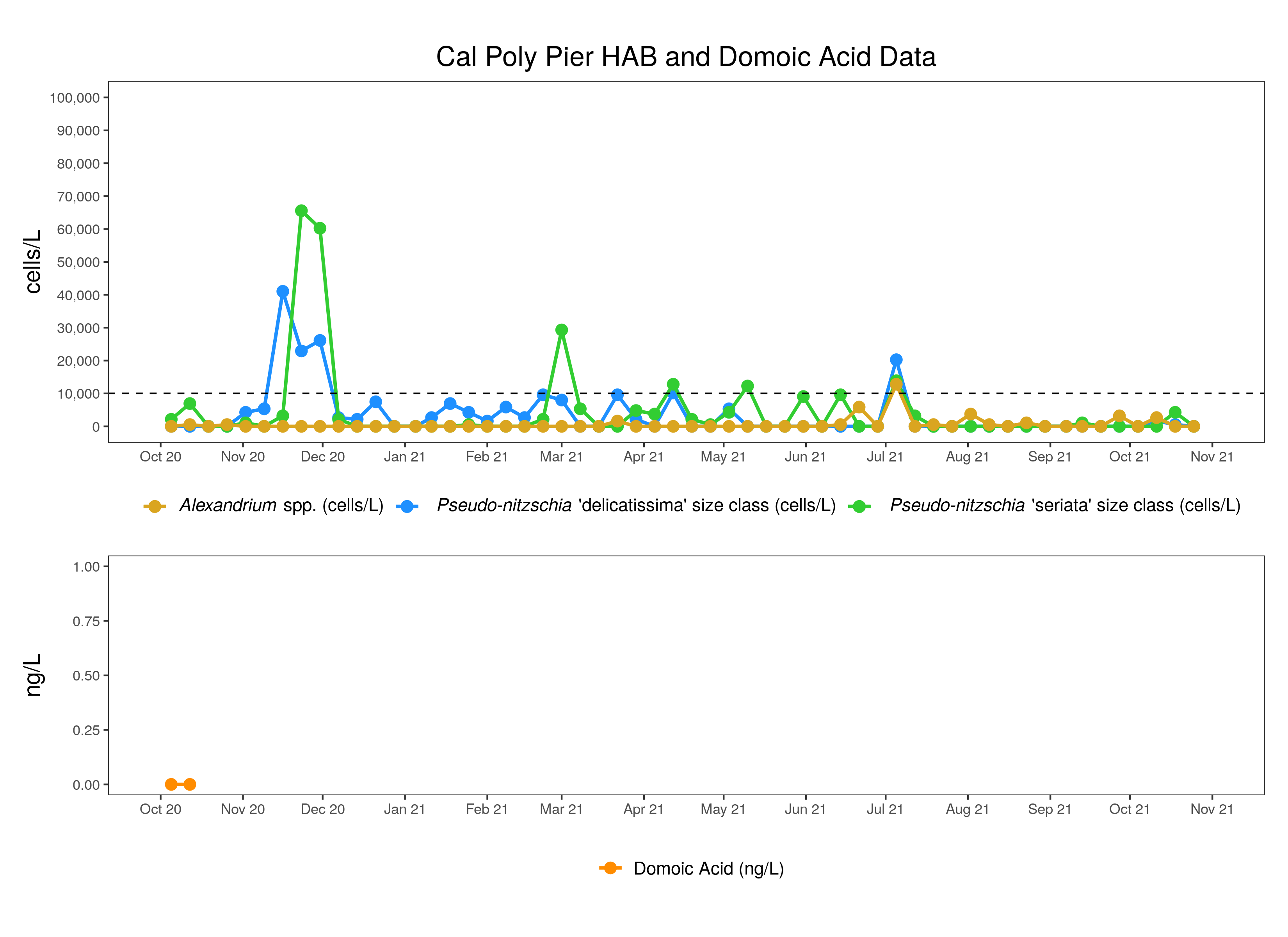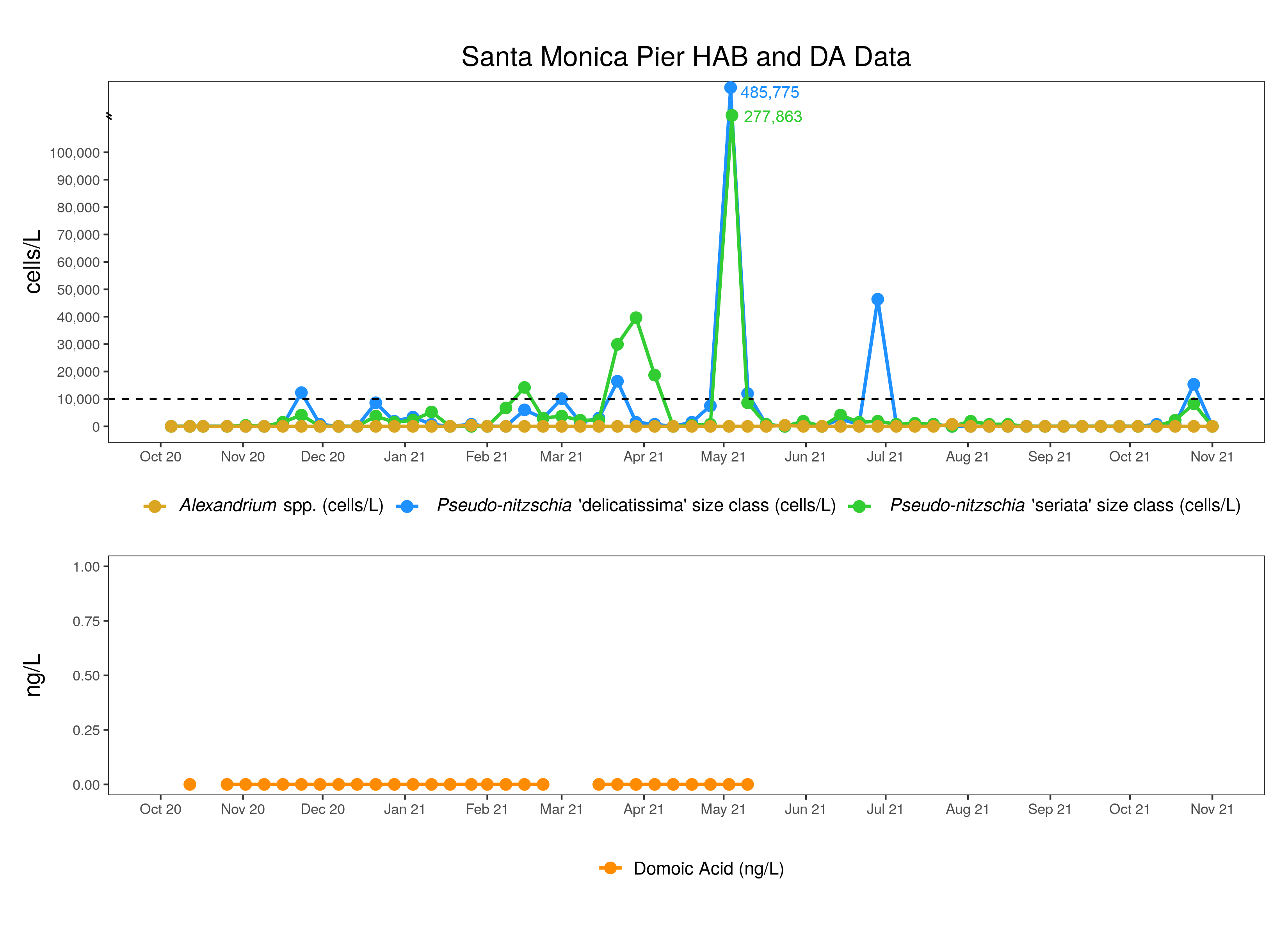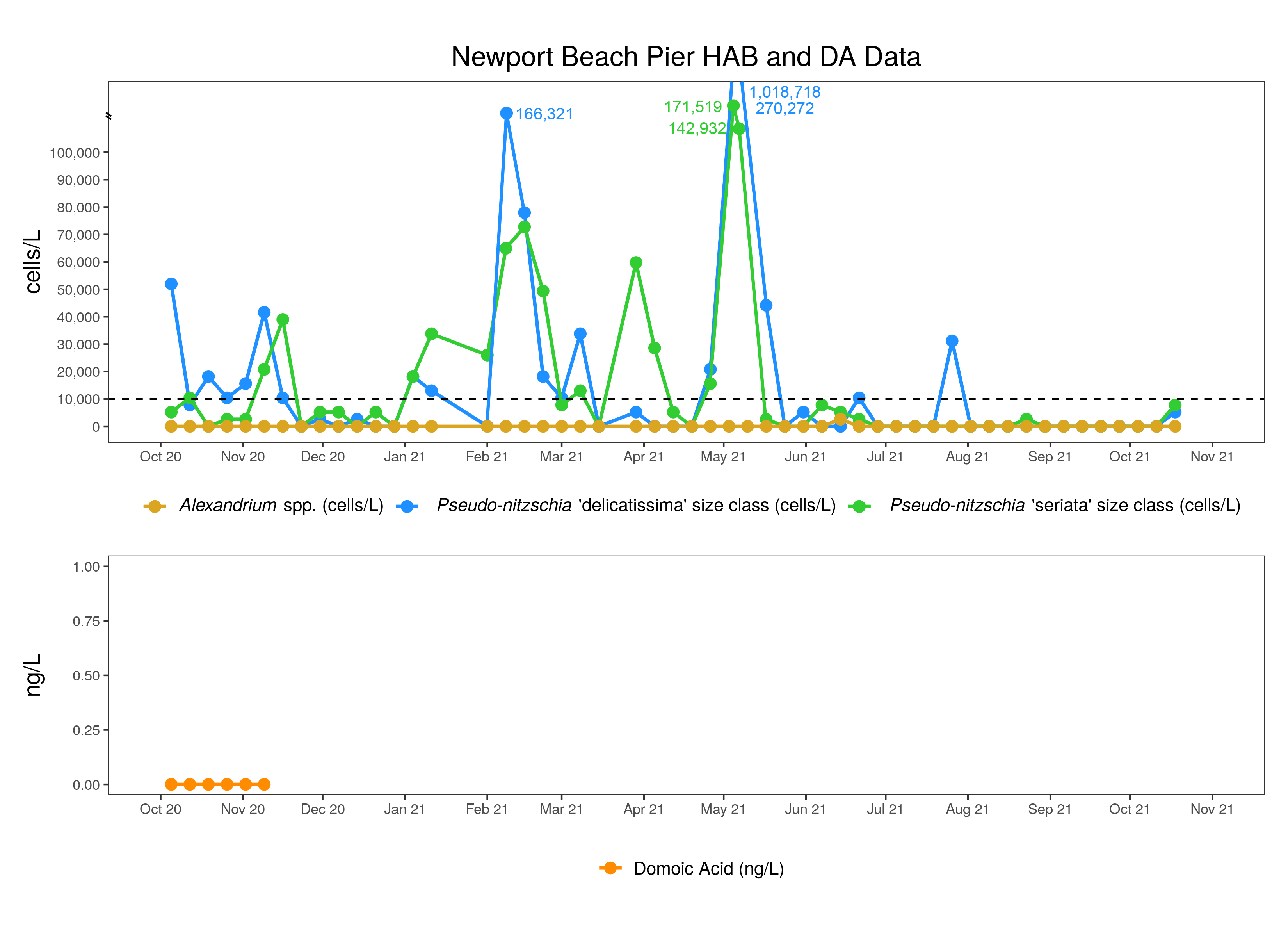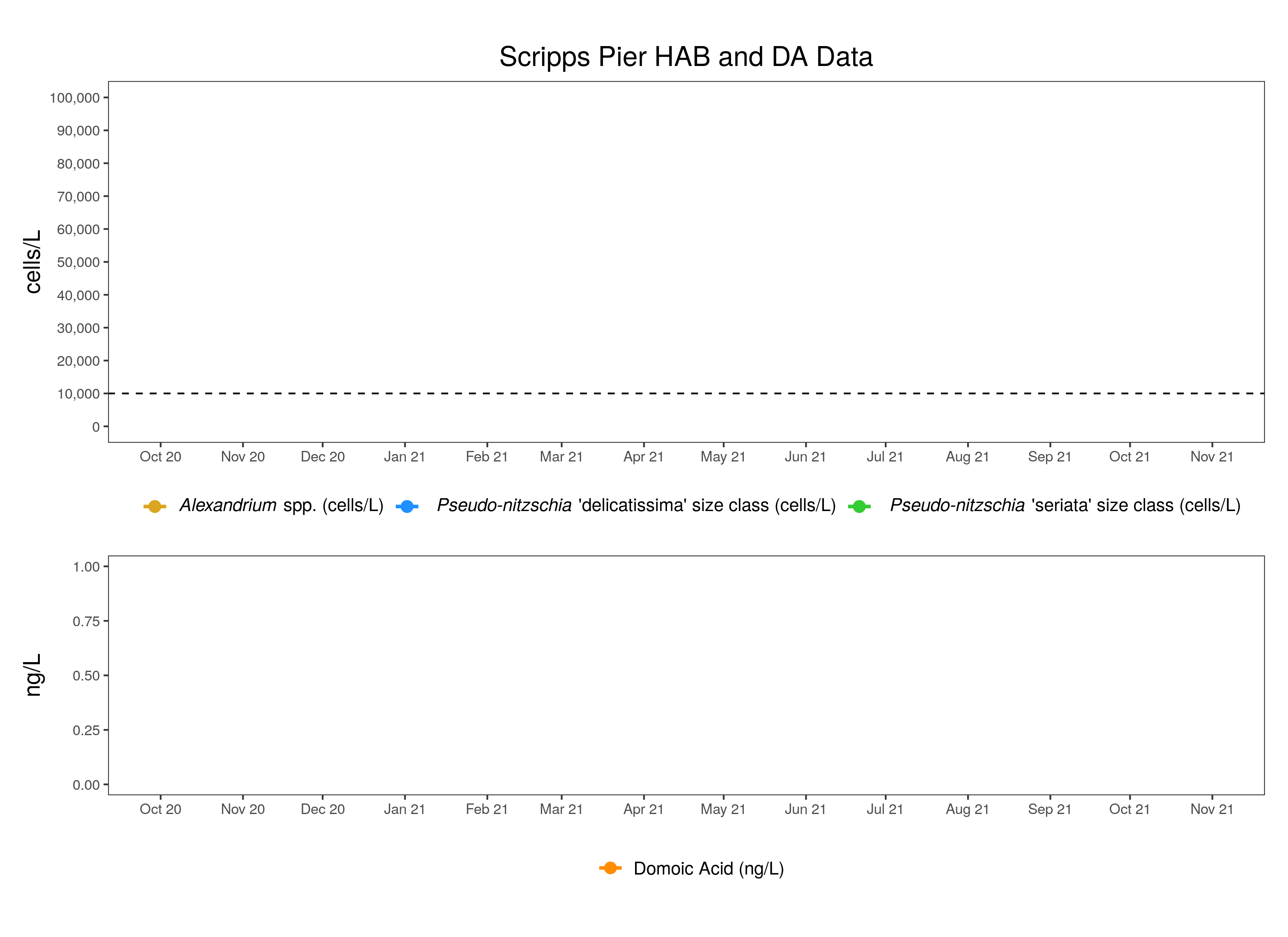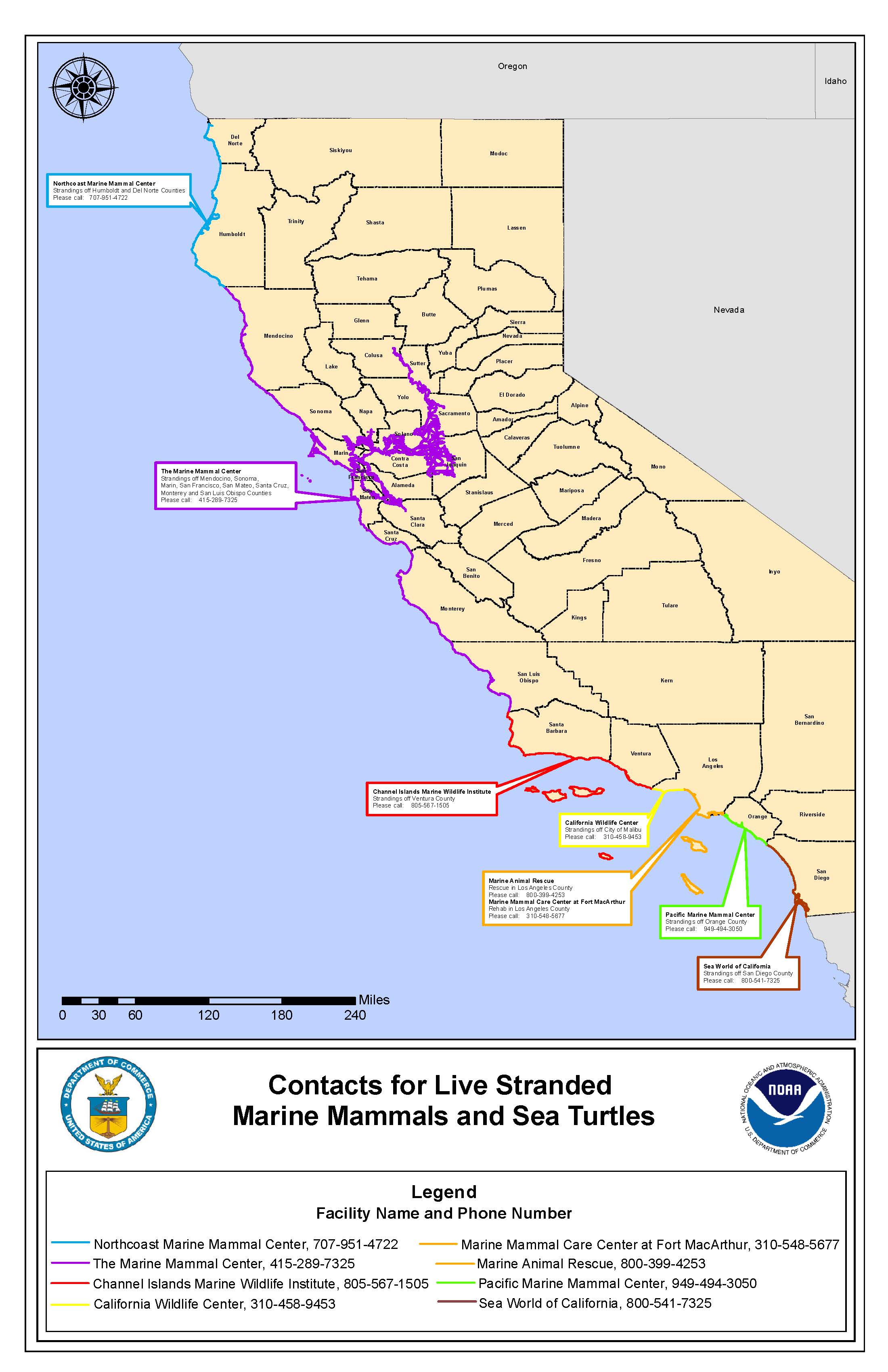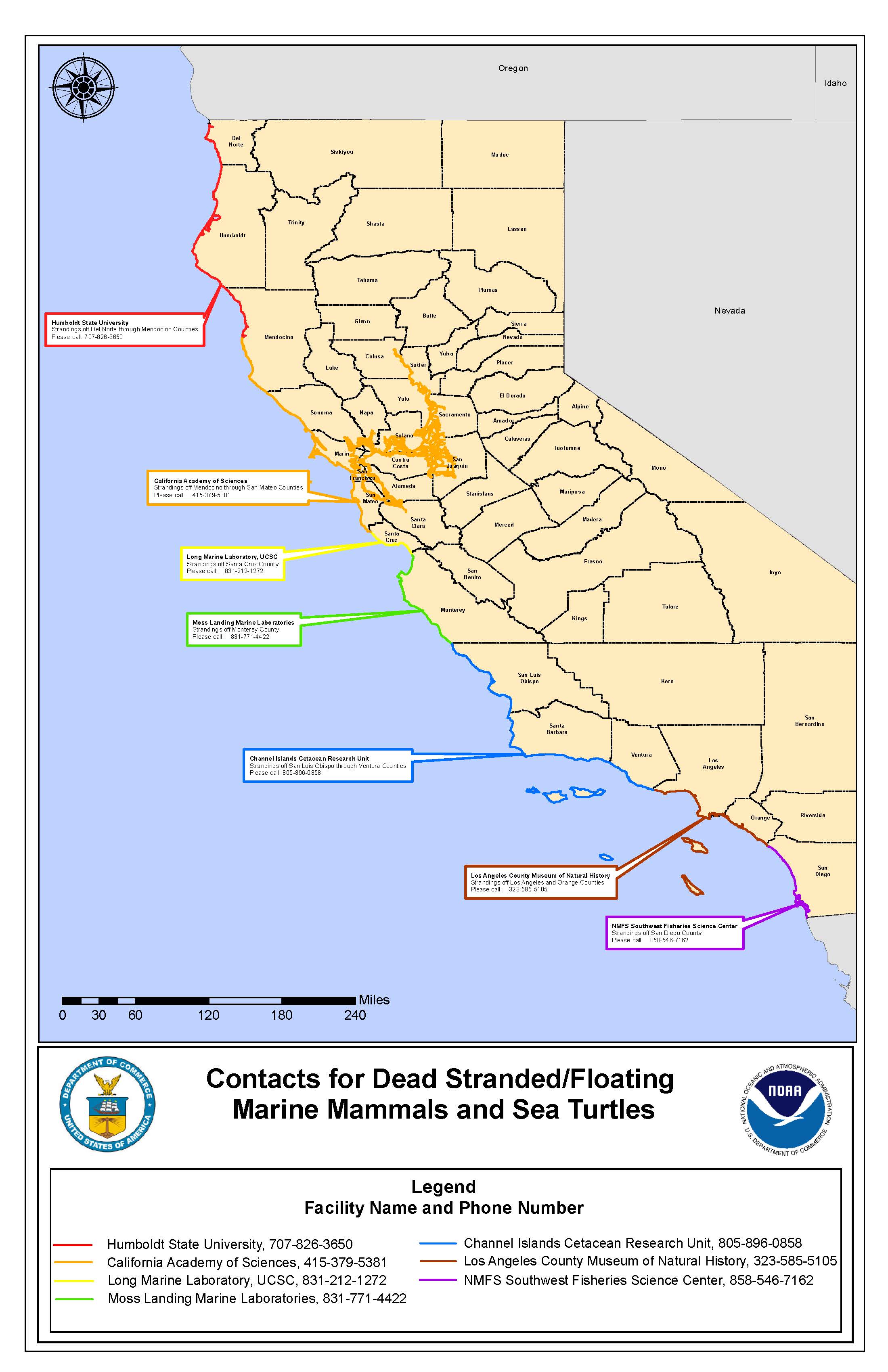Pseudo-nitzschia -
- C-HARM tells us where conditions are suitable for species of the diatom Pseudo-nitzschia spp. (all size classes) to grow well and where they might be more likely to produce the deadly neurotoxin, domoic acid (DA).
- C-HARM predictions in October suggest increased habitat suitability for Pseudo-nitzschia spp. throughout the state compared to last month, with very high bloom probabilities predicted for the entire coast out to many 100s of kilometers offshore
- Bloom levels of the more toxigenic Pseudo-nitzschia 'seriata' size class were present at Stearns Wharf (Santa Barbara Co.) mid-month, and both size classes were at or just above the bloom threshold of 10,000 cells/L at Santa Monica Pier (LA Co.) and Newport Beach Pier (Orange Co.).
- Domoic acid data are reported for Santa Cruz Wharf in October, all samples below detection (i.e. no detectable DA). Data for the other HABMAP pier sites were not yet available for October.
- The nexus of activity from CDPH sampling was the Santa Barbara Channel Islands. The Relative Abundance Index (RAI) for the Pseudo-nitzschia "seriata" size class recorded by the California Department of Public Health (CDPH) reached "Common" levels (10-49%) at San Miguel and Santa Cruz Islands, as well as on one occasion at Trinidad Pier in northern California. The Greater Farallones National Marine Sanctuary Islands hotspot observed in September was not repeat sampled.
- Moderate to very high C-HARM probabilities (50-100%) for particulate domoic acid (pDA) were predicted for three to four main sections of the California coastline in October: the North Coast (much of the month), central Sonoma coastline to the San Francisco Bay region (much of the month), the Santa Barbara Channel region (weighted towards the first half of the month), and parts of southern California (weighted towards the middle to latter half of the month), corroborating the elevated levels of Pseudo-nitzscha spp. observed at the Santa Barbara Channel Islands and Stearns Wharf in mid-October and at Santa Monica and Newport Piers in the second half of October.
- As in September, the highest probabilities for cellular DA (cDA) in October formed an obvious bolus in the North Coast region, expanding this time into the Mendocino and Sonoma County region. This suggests possible issues in northern California at the start of Dungeness crab season, and in fact, there has been a domoic acid advisory issued for recreationally caught Dungeness crab viscera in Sonoma County (as of Nov. 5).
- Interestingly, there were no marine mammal strandings recorded from potential DA toxicosis in the month of October.
- No new shellfish warnings or closures for Amnesic Shellfish Poisoning were added in October, but note the Nov 5th advisory for domoic acid and Dungeness crab. The annual mussel quarantine for domoic acid was lifted on October 31.
Alexandrium -
- CDPH noted that Alexandrium spp. were "Common" in Morro Bay (10% relative abundance index) in October, which has been the case in that region since July, suggesting an on-going threat there and consistent with HABMAP sampling, which detected elevated Alexandrium spp. at Cal Poly Pier on October 11th. The recreational shellfish advisory related to PSP that was issued for mussels in Marin County (just north of San Francisco) on August 27th was lifted on October 5th.
*Please note that HABMAP sampling, CDPH sampling, and marine mammal rescues have been greatly reduced in response to COVID-19 safety measures.
Summary written by Clarissa Anderson on November 22, 2021
**HABMAP sampling resumed after being suspended in March 2020 in accordance with the Governor's stay at home order. However, COVID-19 safety protocols and sampling restrictions may continue to affect operations and delay results.**
Note that data for some stations are not shown because they are not yet recorded in the public HABMAP archive.
Differentiating Pseudo-nitzschia species by light microscopy is difficult. For this reason, Pseudo-nitzschia "seriata" does not refer to an actual species but rather the larger size class of Pseudo-nitzschia, which is generally a more toxigenic group of species. Alternatively, Pseudo-nitzschia "delicatissima" refers to the smaller size class that is generally non-toxigenic. The dashed line on the plots demarcates the 10,000 cells/L "bloom" threshold designated here for Pseudo-nitzschia populations only.
More information and data visualizations on the statewide HAB network and forecasting system can be found on the California HABMAP website and on the SCCOOS Harmful Algal Bloom page.
Santa Cruz Wharf
Four water samples were collected at Santa Cruz Wharf in October. Molecular probes for toxigenic Pseudo-nitzschia in the "seriata" class are conducted for this site, but was not detected. Alexandrium spp. were detected on three occasions (October 6, 20, 27). Domoic acid was not detected but 3 samples still pending analysis.
The Santa Cruz Wharf shore station is supported by CeNCOOS PI Raphael Kudela at UCSC.
Cal Poly Pier
Four water samples were collected at Cal Poly Pier in October. Pseudo-nitzschia "delicatissima" was detected on October 11 and 18 below the bloom threshold. Pseudo-nitzschia "seriata" was detected on October 18, also below the bloom threshold. Alexandrium spp. were detected on October 11. Domoic acid results are not yet available.
Cal Poly Pier shore station is supported by SCCOOS and PIs Ryan Walter and Ally Pasulka at Cal Poly.
Stearns Wharf
Four water samples were collected at Stearns Wharf in October. Pseudo-nitzschia "delicatissima" was detected each time (October 4, 11, 18, 25) with October 18 and 25 above the bloom threshold. Pseudo-nitzschia "seriata" was also detected on each occasion with October 18 above the bloom threshold. Alexandrium spp. were not detected and domoic acid results are not yet available.
Stearns Wharf is supported by SCCOOS and PIs Mark Brzezinski and Libe Washburn at UCSB.
Santa Monica Pier
Four water samples were collected at Santa Monica Pier in October. Pseudo-nitzschia "delicatissima" was detected on October 11, 18, 25 with October 25 above the threshold. Pseudo-nitzschia "seriata" was detected on October 18 and 25 below the threshold. Alexandrium spp. were not detected and domoic acid results are not yet available.
The Santa Monica Pier shore station is supported by SCCOOS and PI Rebecca Shipe at UCLA.
Newport Beach Pier
Three water samples were collected at Newport Beach Pier in October. Pseudo-nitzschia "delicatissima" and Pseudo-nitzschia "seriata" were only detected on October 18, both below the threshold. Alexandrium spp. were not detected and domoic acid results are not yet available.
Newport Beach Pier is supported by SCCOOS and PI David Caron at USC.
Scripps Pier
Scripps Pier water samples are not available for April 2020 through October 2021.
Scripps Pier is supported by SCCOOS and PIs Melissa Carter and Clarissa Anderson at UCSD.
CDPH observations for Pseudo-nitzschia "seriata" and Alexandrium spp.
You can view the interactive map and data table of California Department of Public Health (CDPH) data from January 2019 to present, developed by SCCOOS, below. Or, view CDPH Toxic Phytoplankton Observations Map with layers of Pseudo-nitzschia and Alexandrium spp. as well as other phytoplankton species observations (in the pop-up windows).
Data are provided by the Environmental Management Branch of the CDPH. Please note, starting in July 2019, CDPH moved to only reporting Pseudo-nitzschia of the seriata complex and not all Pseudo-nitzschia spp. as previously provided.
Please email CDPH at Susan.Paulukonis@cdph.ca.gov for any potential marine HAB-related illness in humans.
From October 1-31 2021, water samples were collected by volunteers and sent to the California Department of Public Health (CDPH) for analysis.
Pseudo-nitzschia "seriata" group was detected in 43 of the 86 samples:
Pseudo-nitzschia "seriata" was detected at "Common" density levels on 4 occasions:
- 2021-10-04 15% Trinidad Pier
- 2021-10-20 20% San Miguel Island
- 2021-10-20 20% San Miguel Island
- 2021-10-22 15% Santa Cruz Is., Smugglers Cove
Pseudo-nitzschia "seriata" was detected at "Present" density levels on 11 occasions:
- 2021-10-04 1% Humboldt Bay, Indian Is. Ch.
- 2021-10-06 5% Wilson Creek
- 2021-10-12 4% Agua Hedionda Lagoon
- 2021-10-12 6% Mendocino, Noyo Harbor
- 2021-10-18 2% Ventura, Port Hueneme Pier
- 2021-10-19 5% Mendocino, Noyo Harbor
- 2021-10-19 4% Goleta Pier
- 2021-10-19 1% Santa Cruz Is., Prisoners Hrbr
- 2021-10-21 1% Morro Bay, North T-Pier
- 2021-10-23 4% Pacifica Pier
- 2021-10-27 2% Bodega Harbor, USCG Dock
Pseudo-nitzschia "seriata" was detected at "Rare" density levels on 28 occasions:
- 2021-10-01 0.5% Ventura, Port Hueneme Pier
- 2021-10-01 0.5% Port San Luis, Diablo Cove
- 2021-10-03 0.5% Pacifica Pier
- 2021-10-04 0.5% Morro Bay, Boat Launch
- 2021-10-04 0.5% Tomales Bay, Lease #M430-15
- 2021-10-04 0.5% Bolinas Lagoon
- 2021-10-06 0.5% Monterey, Stillwater Cove
- 2021-10-10 0.5% Pacifica Pier
- 2021-10-11 0.5% Tomales Bay, Lease #M430-15
- 2021-10-11 0.5% Morro Bay, Boat Launch
- 2021-10-11 0.5% Humboldt Bay, Indian Is. Ch.
- 2021-10-13 0.5% Santa Cruz Wharf
- 2021-10-14 0.5% Imperial Beach Pier
- 2021-10-15 0.5% Drakes Bay, Chimney Rock LBS
- 2021-10-16 0.5% Ano Nuevo Beach
- 2021-10-17 0.5% Pacifica Pier
- 2021-10-17 0.5% Palos Verdes, OFFSHORE
- 2021-10-18 0.5% Tomales Bay, Lease #M430-15
- 2021-10-19 0.5% Bean Hollow State Beach
- 2021-10-19 0.5% Ventura, Port Hueneme Pier
- 2021-10-20 0.5% Bodega Harbor, USCG Dock
- 2021-10-21 0.5% Imperial Beach Pier
- 2021-10-22 0.5% Port San Luis, Diablo Cove
- 2021-10-25 0.5% Tomales Bay, Lease #M430-15
- 2021-10-25 0.5% La Jolla, Scripps Pier
- 2021-10-25 0.5% San Simeon Pier
- 2021-10-26 0.5% Imperial Beach Pier
- 2021-10-27 0.5% Drakes Bay, Chimney Rock LBS
Alexandrium spp. were detected in 27 of the 86 samples:
Alexandrium spp. were detected at "Common" density levels once:
- 2021-10-21 10% Morro Bay, North T-Pier
Alexandrium spp. were detected at "Present" density levels on 8 occasions:
- 2021-10-01 5% Port San Luis, Diablo Cove
- 2021-10-01 5% Ventura, Port Hueneme Pier
- 2021-10-04 2% Morro Bay, Boat Launch
- 2021-10-05 1% Tomales Bay, Lease #M430-06A
- 2021-10-17 1% Pacifica Pier
- 2021-10-22 5% Port San Luis, Diablo Cove
- 2021-10-23 5% Pacifica Pier
- 2021-10-27 1% Monterey Bay, Commercial Wharf
Alexandrium spp. were detected at "Rare" density levels on 18 occasions:
- 2021-10-01 0.5% Santa Barbara, Mohawk Reef
- 2021-10-01 0.5% Santa Barbara Ch., Naples Pt
- 2021-10-03 0.5% Pacifica Pier
- 2021-10-04 0.5% Tomales Bay, Lease #M430-15
- 2021-10-04 0.5% Trinidad Pier
- 2021-10-07 0.5% Port San Luis, Diablo Cove
- 2021-10-09 0.5% Monterey Bay, Fishermans Wharf
- 2021-10-10 0.5% Pacifica Pier
- 2021-10-11 0.5% La Jolla, Scripps Pier
- 2021-10-11 0.5% Humboldt Bay, Indian Is. Ch.
- 2021-10-13 0.5% San Diego Bay, U.S. Navy Pier
- 2021-10-16 0.5% Ano Nuevo Beach
- 2021-10-18 0.5% Tomales Bay, Lease #M430-15
- 2021-10-20 0.5% San Miguel Island
- 2021-10-20 0.5% Bodega Harbor, USCG Dock
- 2021-10-23 0.5% San Francisco, Presidio Pier
- 2021-10-23 0.5% Trinidad Pier
- 2021-10-25 0.5% San Simeon Pier
CDPH and OEHHA Health Advisories
November 5. Due to the detection of elevated levels of domoic acid, a naturally occurring toxin, the California Department of Public Health (CDPH) is warning consumers not to eat the viscera (internal organs) of Dungeness crab caught in coastal waters.
October 29. The California Department of Public Health (CDPH) announced that the statewide annual quarantine on mussels gathered by sport harvesters from California's ocean waters ends at midnight on Saturday, October 31, 2021, for all coastal counties.
October 5. The California Department of Public Health (CDPH) has lifted the August 27, 2021 shellfish safety notification related to sport-harvested clams and scallops in Marin County.
August 27. Dangerous levels of paralytic shellfish poisoning (PSP) toxins have been detected in mussels from Marin county.
April 30. The California Department of Public Health (CDPH) announced the annual quarantine of sport-harvested mussels gathered along the California coast.
For the latest closures and updates, please visit the CDPH Health Advisories page as a central location of information related to CDPH health advisories. Also available is a map showing the current CDPH Recreational Bivalve Shellfish Advisories (see below).
NEWS: The HAB-related illness workgroup has developed a new webpage for marine HAB-related illness tracking work (https://oehha.ca.gov/fish/general-info/marine-harmful-algal-bloom-hab-related-illness-tracking).
California Marine Mammal and Seabird Strandings from Suspected DA Toxicosis
Domoic acid (DA) is a potent neurotoxin produced by some diatom species of the genus Pseudo-nitzschia. Species exposed to DA can result in seizures, epilepsy, cardiomyopathy, and death depending upon the ingested dose. DA toxicosis commonly occurs in California Sea Lions (Zalophus californianus), presumably due to a combination of foraging behavior and seasonal movements. The Marine Mammal Center (TMMC), Channel Islands Marine Wildlife Institute (CIMWI), California Wildlife Center (CWC), Marine Mammal Care Center Los Angeles (MMCC-LA), Marine Animal Rescue (MAR), the Pacific Marine Mammal Center (PMMC), and SeaWorld act like an emergency room by working to rescue and rehabilitate sick and injured marine mammals, seabirds, and sea turtles.
Among the six rehabilitation centers we received data for in the month of October, no marine mammal strandings presented with symptoms of domoic acid toxicosis.
The TMMC, CWC, PMMC, CIMWI, SeaWorld, MMCCLA did not record any strandings due to suspected domoic acid in October 2021.

